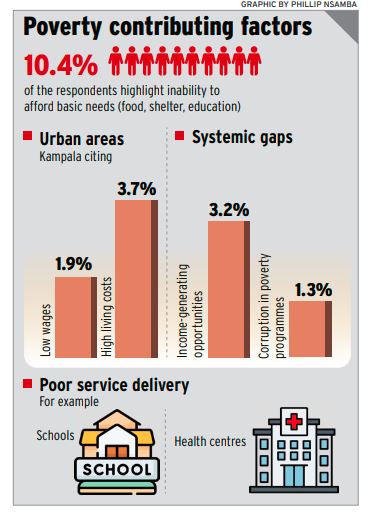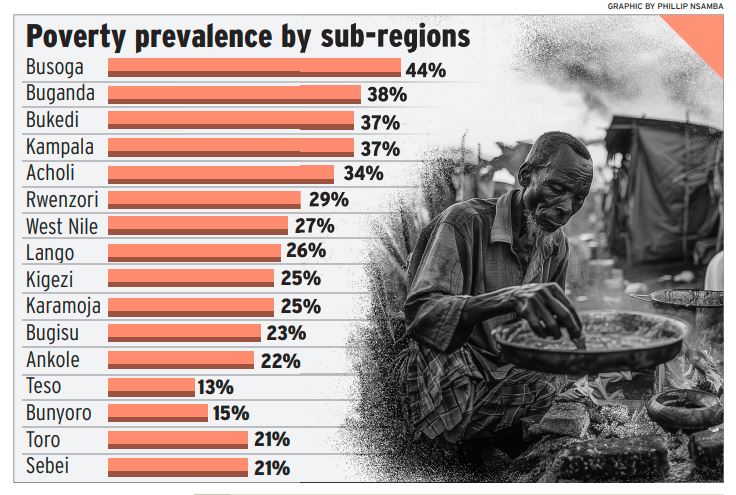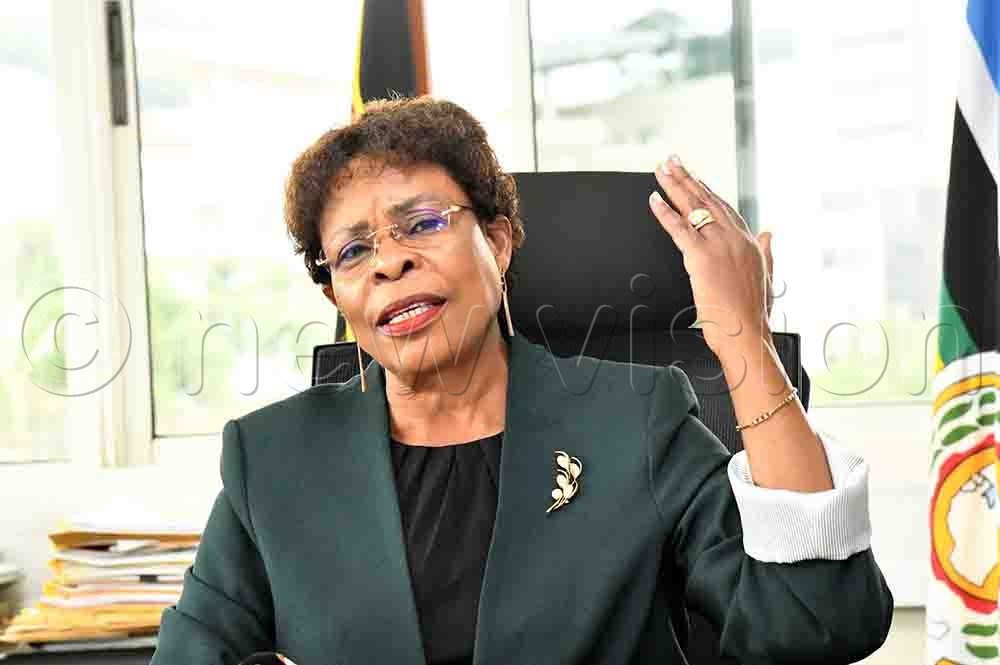2026 Elections: The poverty question, Ugandans speak out
Kampala Central division poverty-driven crises reported 6.3% of issues tied to “high taxation” and 6.3% to “high cost of goods”. Low wages and high rents push residents into informal jobs like vending, riding bodaboda or crime, such as theft cited in Kisoro district.
A welder making a bed in Katwe, Kampala. The Government has crated poverty alleviation schemes, such as Emyooga, to provide capital for businesses.
By John Odyek
Journalists @New Vision

CITIZENS' MANIFESTO
While the majority of Ugandans, especially the youth, look for jobs at established companies or search for white-collar careers, Kampala city-based Edward Nkurikiye, 59, claims to have found ‘gold’ in garbage collection.
He says the job he started in 2005 brought prosperity, adding that he owns 10 rentals (bedsitters) in Kansanga, Makindye in Kampala.
“However, some other people with whom I began were only working for the day. They did not invest. Today, they complain about how the Government has made them poor, but wealth is with us here.”
Nkurikiye is among the millions of Ugandans who have moved out of poverty into the money economy over the past three decades.
It is in these decades that Uganda has achieved remarkable economic growth and substantial poverty reduction.
However, as Uganda heads toward the 2026 general election, a nationwide survey by Vision Group reveals that poverty is the most pressing issue cited by communities across the country.
The Citizens’ Manifesto and opinion poll, conducted in all 17 sub-regions, aimed to capture public sentiment on governance, service delivery and development priorities.
The study reached 6,006 eligible voters through a stratifi ed random sampling method, ensuring demographic and regional balance. A question was asked: “In your opinion, which issues are affecting this community?”
Health services were cited by 53% of respondents. Education followed at 35%. Poverty and transport infrastructure were each mentioned by 29%, indicating concerns about socio-economic hardships and bad roads.

The responses showed that poverty is most prevalent in the central region, reported at 38.1% but declines progressively in the eastern region, standing at 30.8%, the northern region recorded at 28.1% and the western region standing at 21.8%.
Poverty is highly cited in Busoga (44%), Buganda (38%), Bukedi (37%), Kampala (37%) and Acholi (34%). It is cited in Rwenzori (29%), West Nile (27%), Lango (26%), Kigezi and Karamoja (25%), Bugisu (23%) and Ankole (22%).
It is significantly less of a concern in Teso (13%), Bunyoro (15%), Toro and Sebei (21%).
Urban poverty
Kawempe division, one of Kampala’s most densely populated and marginalised areas, is a hotspot of urban poverty. In slum settlements like Bwaise, residents grapple with chronic unemployment, poor sanitation, frequent flooding and inadequate access to basic services.
“The employment in the public sector is also hard since there is a lot of bribing required for you to get a job,” a respondent said.
Kawempe is routinely cited as one of Uganda’s most severely affected urban zones, with its slums standing as stark symbols of deepening economic and social distress. Latrine facilities are scarce, waste management is inefficient and clean water is often out of reach.
These harsh conditions fuel a cycle of illiteracy, disease and low incomes. Every night, Kawempe resident Joan Asiimwe, 22, lies awake on a thin mattress in her rented bedsit listening to her children breathe in the dark.
The shanty house, patched with plywood and plastic sheets to keep out the wind and rain, costs her sh50,000 a month.
By day, Asiimwe washes clothes for neighbours, earning sh7,000 per day. She uses part of this money to buy a kilogramme of maize flour.
Asiimwe prepares mainly porridge for the family meals. “Some days, I don’t make any money and the children cry because there is no food,” she says.
In the same city division, a few kilometres away at Makerere Kavule, Juma Kamya fries chapatis under a flickering roadside bulb. At 20, he is a father trying to grow a street food business that barely breaks even.
“If I had even a little capital, I could make this work,” Kamya says, “But the people I lend to do not pay back.”
Their stories echo the voices of millions of Ugandans grappling with the daily realities of poverty, a struggle that has emerged as the single most pressing concern for citizens ahead of the 2026 general election.

Dominant issues under poverty
Of all the respondents who cited poverty as being a top issue, 62% cited “high levels of poverty”, with severe impacts on education (for example, school dropouts due to costs in the districts of Kisoro and Nebbi), healthcare access and food security.
Rural areas, like in the districts of Agago and Adjumani, reported poverty linked to climate-affected agriculture and low crop prices.
Contributing factors
Among the contributing factors are economic constraints: 10.4% of the respondents under poverty being the most pressing issue highlighted inability to afford basic needs (food, shelter, education), with urban areas like Kampala citing low wages (1.9%) and high living costs (3.7%).
Systemic gaps, including limited income-generating opportunities (3.2%), corruption in poverty programmes (1.3%) and poor service delivery (for example schools, health centres), exacerbate struggles.
Respondents also pointed to related challenges such as limited access to capital, weak cash flow, low or delayed wages, inadequate access to affordable and nutritious food and the negative impact of gambling, all of which hinder business growth and household well-being.
Geographical hotspots
In northern Uganda (Acholi and West Nile sub-regions), over 57% reported poverty-driven crises like early marriages, hunger and unemployment.
In Adjumani district, 75% of the respondents said poverty stems from agricultural dependency and market failures.
Kampala Central division reported 6.3% of issues tied to “high taxation” and 6.3% to “high cost of goods”. Low wages and high rents push residents into informal jobs like vending, riding bodaboda or crime, such as theft cited in Kisoro district.
A respondent in Aswa, Gulu, said: “Poverty has led to hardships, forcing families to prioritise survival over education.”
Respondents in western Uganda (Kigezi, Bunyoro) blamed high poverty rates (for example, Kisoro’s 78.4%) on subsistence farming and remoteness.
Human impact
In Kisoro district, because of poverty, many learners miss meals, affecting learning.
In Kisoro’s Bufumbira South, 62.5% of the respondents cited “inability to afford basic needs” as a barrier to education. In Nebbi district, poverty forces girls into early marriages, while in Gulu district, respondents cited malnutrition and poor sanitation as the consequences of poverty.
Many respondents, who cited poverty as a key issue that they want their leaders to address, said there were accountability and policy gaps in government poverty alleviation initiatives because of corruption and inefficiency.
The respondents urged the local leaders to prioritise job creation, fair wages and anti-corruption measures.

Uganda’s Gini coefficient by region. The Gini coefficient is a key measure of income inequality. This shift indicates a gradual shift towards a fairer income distribution.
Statistics from other bodies
The 2023/2024 Uganda National Household Survey (UNHS) report launched in May, shows that in 2019/20, about 20.3 out of every 100 people were living below the poverty line.
However, by 2023/24, that number dropped to 16.1 out of every 100 people.
This is attributed to improved agricultural incomes among poor households and improved regional markets after the end of the conflicts in the northern region.
This achievement is representative of the collective efforts of the Government (has invested over sh9 trillion in key wealth creation initiatives), its partners and citizens in addressing one of Uganda’s most pressing challenges: Poverty.
These initiatives include:
• Sh1.45 trillion in the Uganda Development Bank
• Sh3.3 trillion allocated to the Parish Development Model by the end of the 2024/25 financial year
• Sh553b for the Emyooga programme
• Sh207.95b for the Youth Livelihood Programme n Sh100b for the Small Business Recovery Fund
• Sh495b in the Agricultural Credit Facility n Sh12.5b for the Youth Venture Capital Fund n Sh168b for the Uganda Women Entrepreneurship Programme
• Sh800b for the Investment for Industrial Transformation and Employment (INVITE) project
• Sh824b for the Generating Growth Opportunities and Productivity for Women Enterprises (GROW) project
• Sh1.2 trillion for the Uganda Development Corporation
Despite these efforts, critics highlight corruption, poor planning, bureaucratic inefficiencies and financial illiteracy among beneficiaries as major obstacles to success.
The Inspectorate of Government’s latest report reveals Uganda loses approximately sh9.7 trillion annually to corruption, driven by tax evasion, ghost workers, inflated payrolls, and flawed procurement processes. Regions like central and northern Uganda, where poverty is most acute, also face persistent land conflicts.
In central Uganda, disputes stem largely from the mailo land tenure system, prompting the Government to issue free land titles to poor residents in Buganda to reduce disagreements and boost productivity.
In the north, post-conflict recovery programmes like the Northern Uganda Social Action Fund and the Peace, Recovery and Development Plan have been implemented since 2011.
Urban vs rural priorities
The poll revealed a contrast between urban and rural priorities. Urban centres like Kampala focused more on employment and infrastructure, while rural areas such as Karamoja, Teso, and Bunyoro prioritised healthcare, education, and agricultural development.
Less prominent but noteworthy issues were highlighted: Land conflicts are more significant in Acholi (13%), West Nile (13%), and Teso (11%). Business and economic concerns are stronger in Kampala (16%) and Ankole (12%).
Child-related issues stand out in Sebei (32%), much lower elsewhere. Domestic, political, traditional, and media issues generally stay below 10% across regions but reflect local dynamics.
Florence Nnassanga Kijudde from Nansana municipality in Wakiso emphasised the importance of education in fighting poverty. She pointed out that without education, it is difficult to secure employment, which can lead to persistent poverty.
“If we were all educated, it would be easier to get jobs and overcome poverty,” Nnassanga said.

IGG Beti Kamya
Income inequality narrows slightly
The survey reveals a positive trend in income distribution. Uganda’s Gini coefficient, a key measure of income inequality, declined from 0.413 in 2019/20 to 0.382 in 2023/24.
This shift indicates a gradual movement toward a fairer distribution of income. In the central region, inequality decreased from 0.412 to 0.369 — a significant improvement, though many people in the region remain economically vulnerable.
The Gini coefficient ranges from 0 (perfect equality) to 1 (maximum inequality). Uganda’s declining coefficient suggests that while inequality is shrinking, the country still faces the pressing challenge of eliminating poverty.
Poverty reduction at budget’s core
Uganda’s 2025/26 national budget places poverty reduction at the heart of its economic transformation agenda. With a focus on commercial agriculture, industrialisation and expansion of the services sector, the budget seeks to accelerate the full monetisation of the economy.
It marks the first fiscal year of implementing the National Development Plan IV (NDPIV), which prioritises higher household incomes, full economic participation, and job creation as key drivers of sustainable socio-economic transformation.
Boosting govt programmes
Finance ministry permanent secretary Ramathan Ggoobi says key government programmes, including the Parish Development Model and Emyooga, are prominently supported in the budget.
These programmes aim to uplift communities and transition households from subsistence to market-based economic activities.
Emphasis on domestic resource mobilisation
To reduce dependence on external borrowing, the budget stresses the importance of enhancing domestic revenue collection. Improved resource mobilisation is expected to provide more sustainable funding for national development priorities.
Planning Framework
The Comprehensive National Development Planning Framework, approved in 2007, introduced a long-term vision through six, five-year-long national development plans. So far, three plans have been implemented, with a strong focus on infrastructure and human capital investment to unlock growth.

According to the NDPIV, tourism remains a strategic sector for generating foreign exchange, creating jobs and reducing poverty by offering diverse income-generating opportunities.
Regional inequality persists
Despite government efforts and targeted programmes, regional imbalances persist. Contributing factors include low income levels, weak and underdeveloped regional value chains, inadequate infrastructure and public services, poor governance and public sector management in some areas.
According to the NDPIV, tourism remains a strategic sector for generating foreign exchange, creating jobs and reducing poverty by offering diverse income-generating opportunities.
It cites science, technology and innovation as critical for addressing underdevelopment. It notes that access to clean water and sanitation is crucial for health, nutrition, education, gender equality and economic growth.
Social protection systems are seen as vital. They promote inclusive development and equitable economic growth.
Uganda’s global commitment to poverty eradication aligns with Sustainable Development Goal 1: Eradication of poverty, a key pillar of the 2030 Global Agenda.
Experts' take
Kenneth Asiimwe, an economist with the Civil Society Budget Advocacy Group, says while flagship government poverty alleviation programmes like the Parish Development Model (PDM) are being implemented in the central region, a one-size-fits-all approach presents challenges.
“Each parish receives sh100m [under PDM] regardless of population density,” Asiimwe says.
“This means many eligible people in the central region miss out due to the high population pressure.” Dr Aisha Nanyiti, a lecturer in the department of policy and development economics at the Makerere University School of Economics, says crop production in central Uganda is increasingly difficult and unreliable for farmers trying to make ends meet.
She adds that the sector is vulnerable to price fluctuations, for example, when maize prices fall, farmers often incur heavy losses.
However, she notes that coffee farmers have recently experienced a boom. She urges the Government and regulatory bodies to support farmers by helping them access reliable markets with fair prices.

Voters’ Voices
Juliet Kansiime, resident of Hoima city
To fight poverty, the Government should ensure that all corrupt officials are eliminated from the system because the money intended to benefit the poor is eaten by them.
Julius Mwesige, resident of Buhimba in Kikuube district
The Government should support the farmers to add value to their produce. Many farmers don’t add value to their produce, and they sell it cheaply, incurring losses.
Jennifer Ilungole, Kapelebyong district
The source of poverty is cattle raids by the Karimojong and that has made many of us fail to educate our children.
Humaru Mutengu, resident of Maggwa in Jinja town
The Government should put emphasis on mindset change before providing capital for people to be job creators and tackle poverty.
Emmanuel Bameka, Nsambya village, Ikumbya, sub-county, Luuka district The unstable commodity prices have left rural farmers cheated. A kilogramme of maize dropped from sh1,200 to sh500. How do you expect families to develop?
Allen Kwesiga, Nakirungu, Rukungiri
It is disheartening that people are having one meal a day due to poverty. Even those with matooke can’t sell a bunch beyond sh2,000; some have resorted to treating themselves with herbs.
Raymond Mugume, resident of Hoima city
The Government should invest in the health and education sectors because people spend a lot of money on health and education.
Gilbert Crosby Muhumuza, resident of Fort Portal
The Government should invest in industrialisation for employment and to add value to agricultural produce since most Ugandan households depend on agriculture.
Michael Okodan
We are subsistence farmers who have no capital for engaging in mechanised agriculture that would see us open a lot of land and harvest big.
Additional reporting by Wilson Asiimwe, Ibrahim Ruhweza, Jackie Nambogga, Godfrey Ojore and Robert Adiga